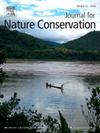IF 2.2
3区 环境科学与生态学
Q2 BIODIVERSITY CONSERVATION
引用次数: 0
摘要
本研究调查了卡斯-凯科瓦海洋保护区(MPA)内的鱼类群落,重点关注连续三个夏季(2022-2024 年)Posidonia oceanica 草甸、沙质岩石栖息地和岩石栖息地之间的差异。我们采用水下目测普查法评估了四个取样点的鱼类多样性、密度以及本地和非本地鱼类物种的存在情况。结果表明,Posidonia草甸支持的本地鱼类密度明显高于其他栖息地,而不同栖息地的本地鱼类物种数量非常接近。不同站点和栖息地的均匀度(J′)值介于 0.47 至 0.63 之间,其中 Posidonia 栖息地的均匀度最低。香农多样性指数(H′)介于 1.42 至 1.82 之间,沙质/岩石区的多样性最高。我们的研究结果提供了对当地栖息地动态的深入了解,但要更全面地了解影响海洋保护区内鱼类群落和非本地物种扩散的因素,还需要进行更广泛的调查,涵盖更广泛的栖息地和环境条件。未来的研究应采用遥感和环境 DNA(eDNA)监测等补充方法,以便更全面地了解鱼类群落的动态。本文章由计算机程序翻译,如有差异,请以英文原文为准。
Fish assemblages in the Kaş-Kekova MPA: A comparative study of Posidonia oceanica meadows, sandy-rocky and rocky habitats
This study investigates the fish assemblages within the Kaş-Kekova Marine Protected Area (MPA), focusing on the differences among Posidonia oceanica meadows, sandy-rocky and rocky habitats over three consecutive summer periods (2022–2024). We conducted an underwater visual census method to assess fish diversity, density, and the presence of native and non-indigenous fish species across four sampling points. Results indicate that Posidonia meadows support remarkably higher native fish density than other habitats, while number of native fish species were very close to each other among habitats. Evenness (J′) values ranged from 0.47 to 0.63 across different stations and habitats and lowest evenness was observed in Posidonia habitat. Shannon Diversity Index (H′) values ranged from 1.42 to 1.82, and the highest diversity was observed at sandy/rocky area. Our results provide insights into local habitat dynamics, broader surveys encompassing a wider range of habitats and environmental conditions are needed to develop a more comprehensive understanding of the factors influencing fish assemblages and the spread of non-indigenous species within the MPA. Future research should incorporate complementary methodologies, such as remote sensing and environmental DNA (eDNA) monitoring, to provide a more comprehensive understanding of fish community dynamics.
求助全文
通过发布文献求助,成功后即可免费获取论文全文。
去求助
来源期刊

Journal for Nature Conservation
环境科学-生态学
CiteScore
3.70
自引率
5.00%
发文量
151
审稿时长
7.9 weeks
期刊介绍:
The Journal for Nature Conservation addresses concepts, methods and techniques for nature conservation. This international and interdisciplinary journal encourages collaboration between scientists and practitioners, including the integration of biodiversity issues with social and economic concepts. Therefore, conceptual, technical and methodological papers, as well as reviews, research papers, and short communications are welcomed from a wide range of disciplines, including theoretical ecology, landscape ecology, restoration ecology, ecological modelling, and others, provided that there is a clear connection and immediate relevance to nature conservation.
Manuscripts without any immediate conservation context, such as inventories, distribution modelling, genetic studies, animal behaviour, plant physiology, will not be considered for this journal; though such data may be useful for conservationists and managers in the future, this is outside of the current scope of the journal.
 求助内容:
求助内容: 应助结果提醒方式:
应助结果提醒方式:


